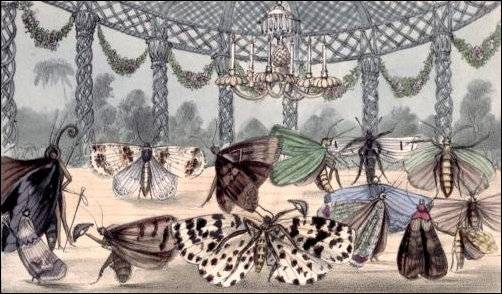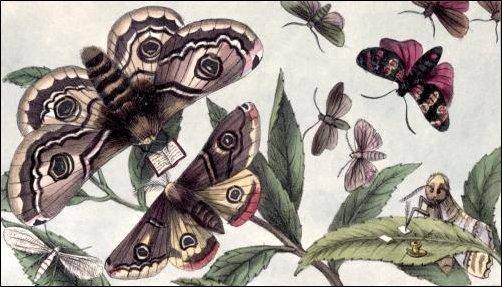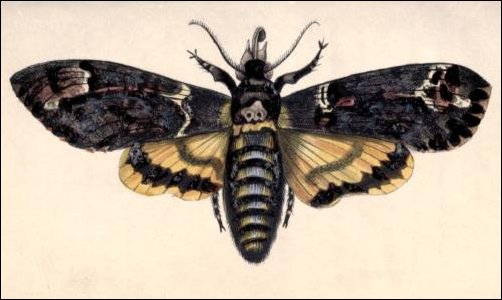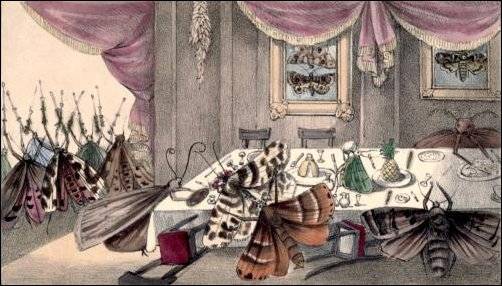[p2]
M. Gauci delt.
Printed by C. Motte 23. Leicester Sqre.
[p3]
THE
EMPEROR’S ROUT.
ILLUSTRATED BY COLOURED PLATES.
LONDON:
CHARLES TILT, 86, FLEET STREET.
MDCCCXXXI.
[p4]
LONDON:
BRADBURY AND EVANS, PRINTERS,
BOUVERIE STREET.
[p5]
THE EMPEROR’S ROUT.
[p6a]
M. Gauci delt.
Printed by C. Motte 23. Leicester Sqre.
THE INVITATION.
[p14a]
M. Gauci delt.
Printed by C. Motte 23. Leicester Sqre.
THE DEATH’S HEAD MOTH.
[p34a]
M. Gauci delt.
Printed by C. Motte 23. Leicester Sqre.
THE ALARM.
1 Saturnia pavonia minor. The caterpillars of these moths are of a beautiful green, with blue spots, and after living together for three weeks, they separate, and disperse themselves in all directions. The Chrysalis is covered with a strongly glutinous matter, which resists not only weather, but the perforation of other insects. The Pavonia Major is the largest of European moths, and, according to Latreille, a manufactory of silk from the cocoons has been established in Germany.
2 Pterophorus pentadactylus. Large White Plume. By some called Ragged Robin. The moths of this genus have their wings divided, or formed of feathers united at the base. The chrysalis is black.
3 Female of the Saturnia pavonia minor.
4 Pygæra bucephala.
5 Endromis versicolor.
6 Noctua catana.
7 Noctua aprilina.
8 Noctua batis.
9 The attitude of the caterpillars, resembling that of the Sphinx, has given this name to the tribe. The moths of the Sphinx have the peculiar power of erecting their wings, but even these cannot make them meet over the back as butterflies do. Their chief food is the potatoe plant.
10 Liparis dispar.—The caterpillars of the Gipsey are very destructive to fruit trees, over which they wander during the day, but at night retire into a web like that of a spider. In 1731, they attacked and destroyed most of the oaks in France.
11 Noctua mi.—Called Shipton, from the profile of an old woman which is marked on its upper wings.
12 Noctua I niger.—The Roman character, I, is marked on the wings of this moth.
13 14 15 Noctua lambda, Noctua gamma, Noctua chi.—So named from the spots on their wings resembling these Greek characters. The caterpillars of the Noctua gamma, in 1735, infected the whole of France, and devoured the productions of the kitchen gardens. The common people supposed them to be poisonous, and consequently the use of herbs in making soups was forbidden.
16 Noctua gothica.
17 Noctua typica.
18 Pyralis genus.—The Tabby is often found in the tea chests in the East India warehouses, where it commits great ravages. It never is met with, however, in a chest that is not cracked, thereby proving its English origin.
19 Noctua nigra.—Black rustic. Noctua lævis.—Grey rustic. Noctua obsoletissima.—Brown rustic. Noctua phæa.—Feathered rustic. Noctua tinea.—Flounced rustic.
20 Notodonta camelina.—The singular name of Coxcomb Prominent, was given to this moth from the crest on its thorax, which resembles that of a cock. The specific name was bestowed in consequence of two lobes on its upper wings, which it raises when at rest.
21 Zeuzera æsculus.—The caterpillar feeds on the wood of apple trees, but the moth is often found in great abundance in St. James’s Park; sixty were gathered there in one morning, but the greater number had been half devoured by the birds.
22 Cossus ligniperda.—The caterpillar lives in the interior of trees, and has, according to Lyonet, 4041 muscles. It is three years before the insect attains its perfect state. The caterpillar emits a smell much resembling that of musk, and Ray and Linnæus both supposed it to be the Cossus mentioned by Pliny, as fattened with flour by the Roman epicures for their tables. Later writers have, however, for many reasons, ascribed this to the larva of the stag beetle.
23 Notodonta dromedarius.—This Notodonta is called Dromedary, from having two crests, similar to humps, on its thorax.
24 Sphinx elpenor.—The caterpillars of the Elephant feed on the plant called Ladies’ Bedstraw, (Galium palustre), from which they are often shaken by the wind into the water. When this happens, they dexterously turn themselves on their backs, make head and tail meet, and float in this posture till they can contrive to save themselves by clinging to some part of the plant. They possess the power of drawing the head and three first joints within the body at pleasure. The moth flies very late at night, and is rarely caught.
25 Lasiocampa rubi.—The Fox moth is chiefly found on heaths and commons, and lives in the caterpillar state all the winter.
26 Hepialus humuli.—The male moth is of a beautiful and brilliant white, but the female is yellow. It is fond of feeding on the roots of grass, and from having been often found in church-yards, the tradition has arisen that it inhabits those spots only. The caterpillar is very destructive to hops, by devouring the roots.
27 Sphinx atropos.—This is called the Death’s Head moth from the resemblance of the spot on its thorax to a human skull. It is the largest of the Sphinx tribe, and is vulgarly regarded as the messenger of pestilence and death. When touched it utters a plaintive cry, like that of a bat or mouse. Reaumur says, that a whole convent in France was thrown into consternation, by one of these moths flying into the dormitory. It frequently robs hives, and Huber states, that its cry renders the bees motionless. It breaks from its chrysalis between four and seven in the afternoon, as the Hawk moth of the Lime always appears at noon, and that of the Evening Primrose at sunrise.
28 Sphinx cellata.—The Eyed-hawk moth flies very swiftly by night, and its caterpillar is very beautiful.
29 Geometra cratægaria.—The Brimstone lays eggs twice in the same year.
30 This genus is so called from the peculiar manner in which the caterpillar moves; it brings the feet of both extremities close together, and the intermediate part of the body rises like an arch, giving it the appearance of measuring the distance it performs. It is said to possess great muscular powers, for it will attach its posterior feet to the twig of a tree, and erect the rest of its body in a vertical position for hours without moving.
31 Geometra subtristata.—&c. &c.
32 Tinea genus.—These are the moths which cause so much destruction to furs, and other articles of clothing. They lay their eggs on the substances which serve them for food. The most effectual method of keeping them away is to pack the materials in a well-closed tin box, and enclose with them a tallow candle.
33 Noctua tetra.
34 Leucania.—Genus of Stephens.
35 Crambus carnea.—Rosy veneer. Crambus arborum.—Yellow satin veneer. They receive their name from the streaks on their wings. They are chiefly found on grasses in flower, and always settled with their heads downwards.
36 Botys genus.—Called China mark, from the resemblance of the spots on the wings to those on old China.
37 Galleria alvearia.—The caterpillar lives on honey.
38 Aglossa pinguinalis.—The food of the caterpillar consists of fat substances, such as butter or lard, in which it will suffer itself to be completely enveloped without injury. It is sometimes said to get into the human stomach, when it causes very dangerous symptoms.
39 Galleria cereana.—The caterpillar feeds on wax, but for want of this food will eat paper, wafers, &c.
40 Hepialus genus.—The gold Swift sometimes moves slowly through the air, a few feet from the ground, where it poises itself; at others, vacillates like the pendulum of a clock, and again altering its motion, darts about with great rapidity.
41 Cerura vinula.—The caterpillar of the Puss has the power of stretching out, or pulling back its head at will, according to its apprehension of danger. Its hinder extremity never touches the ground, but is furnished with two tubes, through which the insect ejects a thin liquor at its pursuers. When near the change into the pupa state, however, the tubes dry up, and it loses this faculty. More male than female moths are to be found, which is contrary to the general rule.
42 Cerura furcula.—The kitten.
43 Lasiocampa quercus.—The Eggar has been known to remain seven years in the chrysalis state.
44 Zygæna genus.
45 Noctua oblonga.
46 Noctua obscura.
47 Porrectaria grandipennis.
48 Noctua meticulosa.—The chrysalis of the Angle-shades is of a deep red colour, with two sharp points at the tail. The caterpillar is of a fine transparent green.
49 Laria genus.—The Tussock feeds on white thorn, and is the hop-dog of the hop-gatherers in Kent.
50 Gastropacha quercifolia.—The caterpillar of this moth also lives through the winter, a fact recently discovered by Mr. Samouelle, from whose obliging communications many of these notes have been derived.
51 Noctua flavicornis.
52 Noctua fraxini.—The Nonpareils are very scarce in England, are very large moths, and have blue under-wings.
53 Noctua triplacea.—Named Spectacle moth, from an appearance like spectacles on its thorax.
54 Noctua conigera.—Brown line. Bright eye.
55 Noctua furca.
56 Sphinx convolvuli.—The unicorn caterpillar is difficult to find, from its habit of hiding itself in the ground, and only appearing on the surface in the evening to feed on the lesser bindweed, at which time it is frequently sought by collectors with a candle and lanthorn. The Pupa has an enormous rostrum, longer than the insect, and very thick, probably to contain the proboscis.
57 Tinea bistriga.—These are beautiful minute insects, and are found on the white thorn in July.
58 Geometra sambucaria.—This is found in lanes, and is remarkable for the elegance of its flight.
59 Noctua typhæ.—The caterpillar feeds on the pith of the bulrush.
60 Geometra punctaria.—The Maiden’s Blush flies in the shady parts of woods at sunset.
61 Noctua libatrix.
62 Erminea padi.—This insect destroys the white thorn hedges in the neighbourhood of London. About three years back, a dress was woven by the caterpillars for the Queen of Bavaria. A model was made of some stiff material, and the caterpillars placed on it; they covered it with their web, and thus produced a garment without a seam.
63 Arctia mendica.
64 Arctia salicis.—The Satin moth not only itself wears the appearance of this substance, but covers its eggs with a web which has the same resemblance.
65 Geometra papilio naria.—66 Noctua perla.—67 Geometra omicromaria.—These moths in colour resemble the stones, &c., after which they are named. The Emerald becomes white with keeping, and the others turn to a dirty yellow.
68 Noctua chrysitis.—The upper wings of the moth are of a light brown, and streaked across with two bands resembling polished brass.
69 Noctua Ethiops.—So named from its dark appearance.
70 Noctua Maura.—The Moor has a broad body, and is constantly found under the arches of Westminster Bridge.
71 Arctia caja.—The caterpillar mixes its own hair with its web. It is found in gardens, feeds on every thing, and changes its skin ten times.
72 Noctua brassica.—The caterpillar is very destructive to cabbages.
73 Noctua persicaria.—This moth is remarkable for a white spot on its wing, and the caterpillar feeds on the flower from which it is named.
74 Noctua erica.—The appearance of a true lover’s knot is found on its upper wings.
75 Macroglossum stellatarum.—It makes a humming noise with the vibration of its wings. It is found from March till September, hovering over geraniums, and constantly appears at two o’clock in the afternoon.
76 Noctua bractea.—This is a rare insect, and receives its name from the large spot in each upper wing, resembling burnished gold.
77 Noctua precox.—This moth was named after the Duchess of Portland, who first found it.
78 Tortrix genus.—The genus receives its name from the faculty possessed by the caterpillar, of rolling or twisting the leaves of the plants it inhabits, into a tubular form. The Christian, or Christianern, is found in the chalk pits of Kent, resting on cinque-foil. The upper wings are of a bright yellow, streaked with scarlet.
79 Ino statices.—The body and wings are of a beautiful metallic green, and they chiefly inhabit meadows.
80 Ægeria genus.—They receive their name from the transparency of their wings. They are principally found on the wood of the currant tree.
81 Noctua tragopogonus.—Called Mouse from its colour.
82 Noctua delphinii.—The Pease blossom is a very beautiful, but rare moth. It feeds on the wild larkspur, and lies in the pupa state from August till the June following.
83 Noctua satellitia.—The caterpillars of the Satellite are great enemies to white thorn, currant, and gooseberry bushes, and also to other caterpillars.
84 Geometra hexapterata.—The Seraph, or Seraphim, has two little processes like the rudiments of another pair of wings, whence its specific name.
85 Noctua cerasi, &c.—These moths are remarkably neat in appearance.
86 Noctua ligustri.—The Coronets are so called from their crested thorax.
87 Geometra luctuaria.
88 Adela genus.—The Japan moths are distinguished by the length of their antennae, which several times exceed the length of their bodies.
89 Abraxas grossulariata.—The destructive caterpillar of this moth lives in gardens, through the winter, and feeds on the buds as they begin to open. When about to change to the chrysalis state, they suspend themselves by the tail.
90 Bombyx antiqua.—The female moth is destitute of wings, and the male is constantly seen, slowly fluttering through the streets of London.
91 Noctua psi.—The Dagger is produced from a light green egg, and is named from the mark on its wings.
92 Herminia rostralis.—Called Snout, from the form of the palpi, which project over the head.
93 Bombyx cæruleocephala.—It owes its English name to the figure of eight, marked in white on its brown wings.
94 Bombyx cassinea.—The Sprawler is found on palings, closely adhering to the wood, and rests with its anterior feet widely spread out.
95 Geometra leucophearia.—This is named Spring Usher from making its appearance in February; it is a favourite food with insectivorous birds.
96 Noctua aprica.
97 Tortrix gnomana.—Dial moth. It flies from side to side like the pendulum of a clock.
98 Lasiocampa neustria, &c.—The caterpillars live in a common web, and are striped with white, blue, and red, whence, by the French naturalists, they are called livrée. They are polyphagus, i. e. they eat every thing. They lay their eggs in close, compact rings, round the twigs of trees.
99 Odenensis potatoria.—The caterpillar of this moth (according to Godart) after drinking, lifts up its head like a hen, whence it receives its name.
100 Lithosia aurantia (orange)—Lithosia luterella (yellow) Lithosia rubricollis (black)—Footman.
101 Noctua chamomilla.—The moth attaches itself close to the edges of wood, as near its own colour as possible.
102 Abraxas ulmaria.—Found abundantly in Yorkshire.
103 Geometra genus.
104 Noctua exclamationis.
105 Geometra chærophyllata.—All the moths called Chimney-sweeps are black, but the Chimney-sweep’s boy is smaller than the others, and easily distinguished by the glossiness of its wings.
106 Fumaria plumistra.
107 Geometra euphorbiata, &c.
108 Geometra thymiaria.—All collectors will recognise this as a very probable accident from the quantity of grease natural to moths, and which often destroys their finest specimens. The localities of these and other insects, with more particulars, may be found ably described in Mr. Samouelle’s valuable work on Entomology.
THE END.
BRADBURY AND EVANS, PRINTERS.